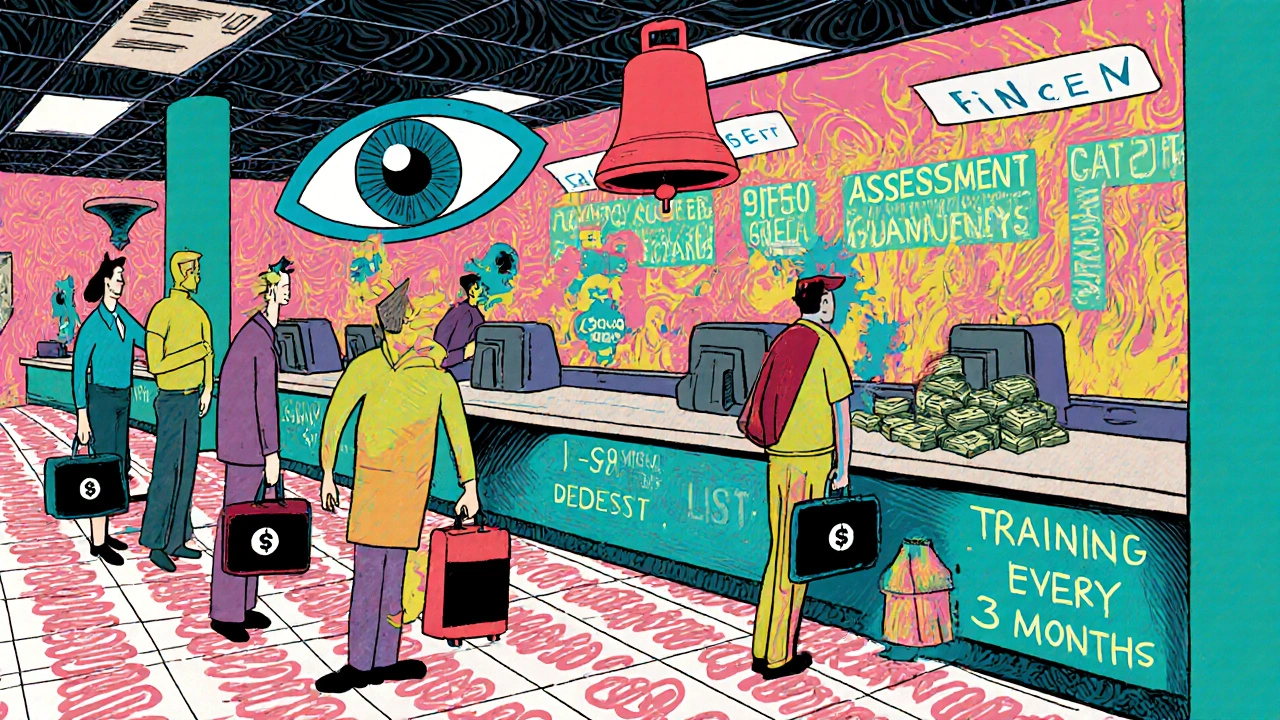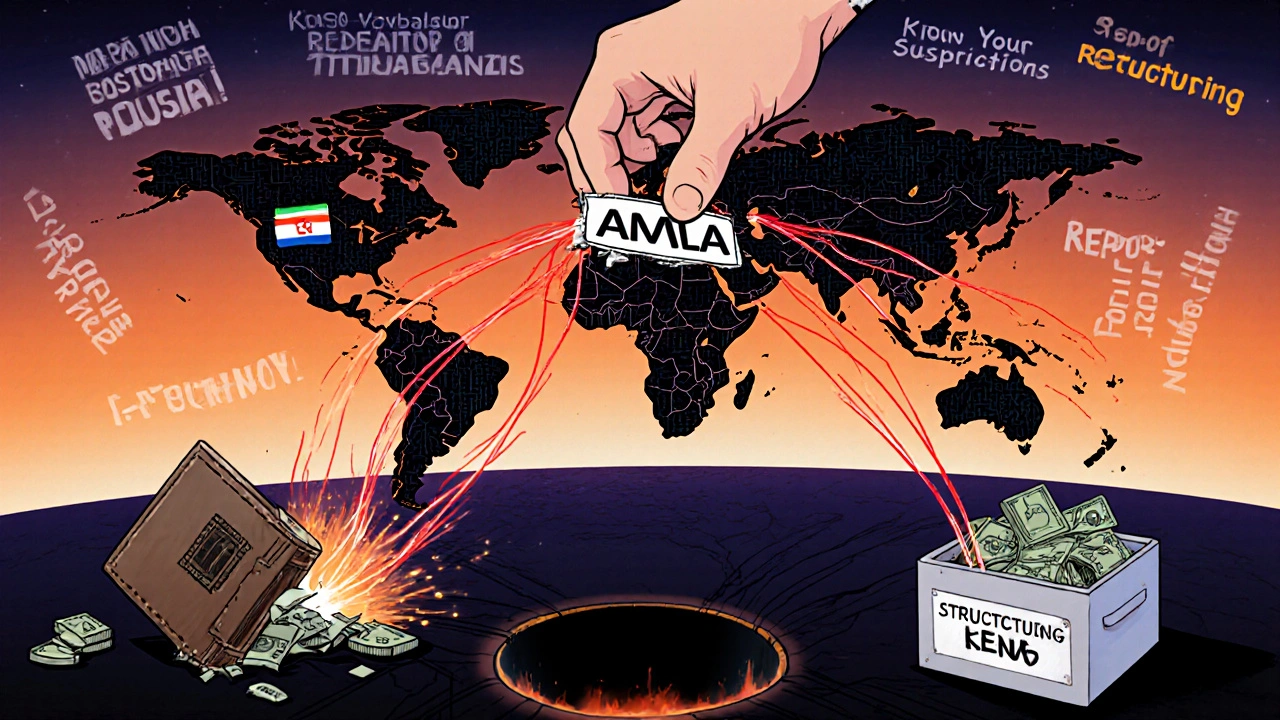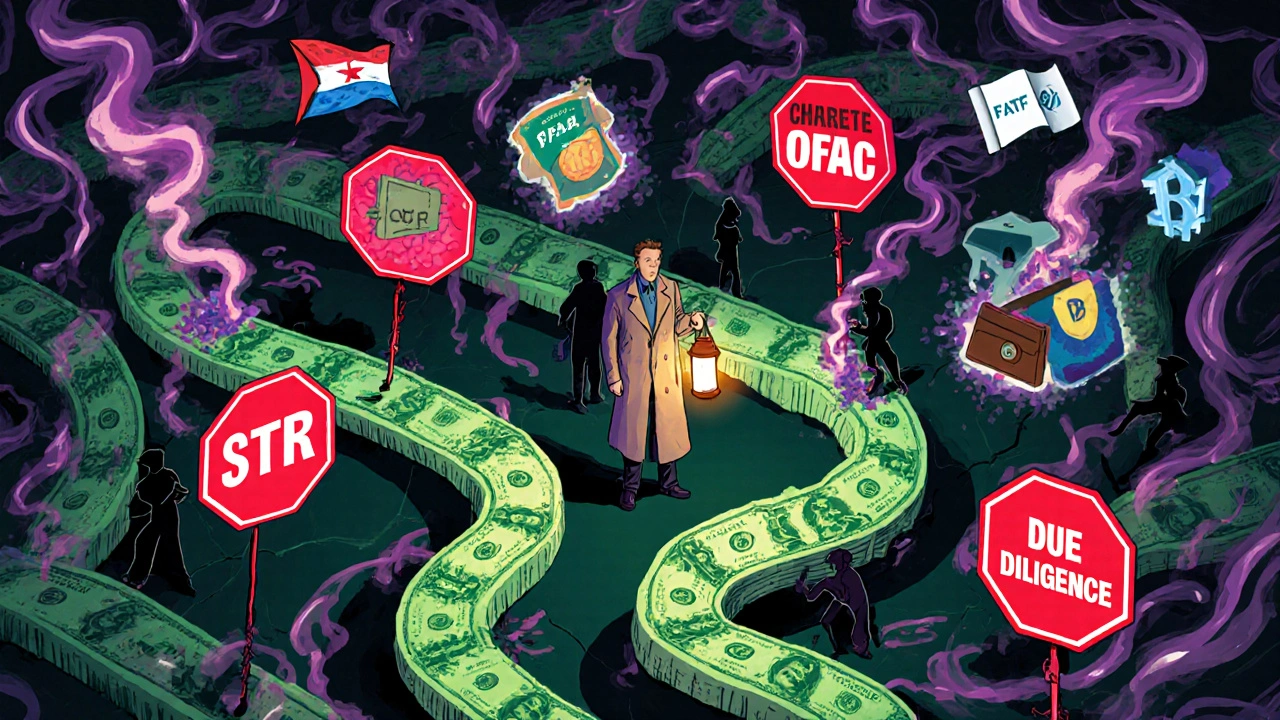CTF Transaction Risk Calculator
Assess Transaction Risk
Calculate risk score based on CTF compliance factors using real-world guidelines from FinCEN and FATF.
Risk Assessment
What Is Counter-Terrorist Financing (CTF)?
Counter-Terrorist Financing (CTF) isn’t about stopping bombs. It’s about stopping the money that makes them possible. Every terrorist attack needs funding-weapons, travel, safe houses, propaganda. CTF is the system designed to cut off that flow. It’s not just law enforcement. It’s banks, payment processors, crypto platforms, and even charities working together to spot and report suspicious cash movements before they reach dangerous hands.
The core idea is simple: if you can’t pay for it, you can’t do it. But the system behind that idea is complex. It’s built on decades of global rules, national laws, and real-time monitoring. The foundation? The Bank Secrecy Act (BSA) a U.S. law enacted in 1970 that requires financial institutions to assist government agencies in detecting and preventing money laundering and terrorist financing. After 9/11, the USA PATRIOT Act a U.S. law passed in 2001 that expanded the BSA to include specific counter-terrorism financing requirements, including enhanced due diligence and reporting obligations made CTF a top priority. Today, every financial institution in the U.S. must have a CTF program-or risk massive fines, license revocation, or criminal charges.
How CTF Works: The Six Pillars of Compliance
CTF isn’t a checklist. It’s a living system. The Financial Crimes Enforcement Network (FinCEN) a bureau of the U.S. Department of the Treasury that administers the BSA and enforces AML/CFT regulations, including issuing guidance and proposed rules on CTF program requirements says any effective CTF program must have six working parts. Missing one weakens the whole thing.
- Risk Assessment - You can’t protect what you don’t understand. Every bank, fintech, or money service business must evaluate its own exposure. Do you serve high-risk customers? Do you operate in countries with weak controls? Do you handle large cash deposits? This isn’t a one-time form. It’s updated quarterly, based on real data.
- Internal Controls - These are the rules your staff follows: how to verify a customer’s identity, how to flag unusual wire transfers, how to handle transactions linked to sanctioned names. These controls must be written, tested, and enforced. No exceptions.
- Designated Compliance Officer - One person, clearly named, responsible for the entire program. They don’t just file reports. They train staff, interpret new rules, and answer regulators’ questions. This isn’t a side duty. It’s a full-time job.
- Employee Training - Frontline staff see the red flags first. A teller notices a customer making $9,500 cash deposits every week to avoid reporting thresholds. A customer service rep gets a strange request to send money to a war zone. Training keeps them alert. It’s not a yearly webinar. It’s quarterly refreshers with real case studies.
- Independent Testing - Someone outside the compliance team audits the program every 12-18 months. They don’t just check boxes. They try to break it. Can they bypass the system? Are alerts being ignored? Are reports filed late? This is where many programs fail.
- Customer Due Diligence (CDD) - Know your customer. Not just their name and address. Their business, their sources of income, their typical transaction patterns. If a charity suddenly starts receiving large cash donations from unknown donors overseas? That’s a red flag. CDD forces institutions to look beyond the surface.
These six pieces don’t work alone. They feed into each other. A risk assessment tells you where to focus training. Training helps staff spot anomalies that trigger independent testing. Testing finds gaps that update your controls. It’s a cycle. Break one link, and the whole system starts to rust.
Reporting: Suspicious Activity Reports and Beyond
CTF isn’t just about stopping bad actors. It’s about telling authorities when something’s wrong. The most important tool? The Suspicious Activity Report (SAR) a confidential report filed by financial institutions with FinCEN when they detect transactions that may involve money laundering, terrorist financing, or other financial crimes.
There’s no minimum dollar amount. If something feels off-unusual timing, odd routing, mismatched customer behavior-you file it. SARs are confidential. You can’t tell the customer you filed one. If you do, you could be breaking the law.
Another key report is the Currency Transaction Report (CTR) a mandatory report filed with FinCEN when a financial institution processes a cash transaction of $10,000 or more in a single day. It’s not about suspicion. It’s about transparency. Any cash move over $10,000 gets recorded. This helps connect dots later.
But reporting doesn’t stop there. If a customer is linked to a sanctioned entity-like a terrorist group or a known financier-you must freeze their assets immediately and notify the Office of Foreign Assets Control (OFAC) a U.S. Treasury agency that administers and enforces economic and trade sanctions based on U.S. foreign policy and national security goals, including counter-terrorism sanctions. OFAC maintains the Specially Designated Nationals (SDN) list. It’s updated daily. Your compliance software must check every customer against it in real time.
Failure to report? Penalties can hit millions. In 2024, a major U.S. bank paid $450 million in fines for missing SARs tied to a known terrorist financier. That’s not a mistake. That’s a system failure.

Global Rules: The FATF and Jurisdictional Risk
CTF doesn’t stop at borders. Terrorists move money across countries. That’s why the Financial Action Task Force (FATF) an intergovernmental body established in 1989 by the G7 to set international standards for combating money laundering and terrorist financing exists. It’s the global rulebook. Its 40 Recommendations are the gold standard for every country.
FATF doesn’t just make rules. It checks if countries follow them. Twice a year, it updates two lists:
- High-Risk Jurisdictions Subject to a Call for Action - Countries with serious CTF failures. As of June 2025, this list includes Iran, North Korea, and Burma. Financial institutions must apply enhanced scrutiny-or avoid doing business there entirely.
- Jurisdictions Under Increased Monitoring - Countries working to fix weaknesses. In June 2025, the British Virgin Islands and Bolivia were added. That means U.S. banks must now treat transactions involving these places as higher risk.
Ignoring these lists is dangerous. If your bank sends money to a sanctioned entity in Iran, even through a third country, you’re breaking U.S. law. That’s why compliance teams now track FATF updates like stock prices. One new name on the list can trigger a full review of your customer base.
EU vs. U.S.: Two Different Approaches
The U.S. and EU both fight CTF-but they do it differently.
In the U.S., it’s a patchwork. FinCEN, OFAC, the Federal Reserve, and the IRS all have roles. Enforcement is aggressive. Penalties are steep. The system relies on individual institutions to self-police under clear rules.
The EU is changing. Until the end of 2025, oversight was spread across national regulators. But starting January 1, 2026, the Anti-Money Laundering Authority (AMLA) a new centralized EU agency replacing the European Banking Authority's AML/CFT functions, designed to enhance cross-border supervision and harmonize enforcement across member states takes over. It’s the first time the EU will have a single body directly supervising large financial institutions across all 27 countries.
Why? Because financial crime doesn’t care about borders. A bank in Latvia might be used to funnel money to a terrorist cell in Germany. Under the old system, no one had the power to stop it. AMLA changes that. It can demand records, launch investigations, and fine institutions directly.
Another big difference? The EU is cracking down on “de-risking.” That’s when banks cut off entire customer groups-like charities or remittance providers-just to avoid risk. The EU says that’s not compliance. It’s cowardice. The right approach is to manage risk, not run from it.

Emerging Threats: Crypto, Charities, and Cash
CTF isn’t static. The bad guys adapt. So must we.
Crypto is the biggest challenge. Digital assets move fast, cross borders easily, and often hide identities. The EBA and FinCEN now require crypto exchanges to collect and share sender/receiver info on every transaction-just like banks do with wire transfers. This is called the “Travel Rule.” Many platforms still struggle to implement it properly.
Charities are another blind spot. Legitimate NGOs are often used to move money under the guise of aid. In 2023, a U.S.-based charity was found funneling $2.3 million to a designated terrorist group through fake humanitarian projects. CTF programs now require deeper due diligence on nonprofit donors and overseas partners.
Cash remains a favorite. It’s untraceable. That’s why CTRs matter. But criminals are getting smarter. They break up large deposits into smaller ones-called “structuring.” Banks must train staff to spot patterns: five $9,000 deposits in a week from the same person? That’s not coincidence. That’s a red flag.
What Happens When CTF Fails?
When CTF breaks down, the cost isn’t just financial. It’s human.
In 2024, a small regional bank in Texas failed to file SARs on a customer who sent over $1.2 million to Syria over 18 months. The money was used to buy weapons. The bank paid $120 million in fines. The CEO resigned. The compliance officer was criminally charged.
But the real cost? The lives lost in the attack that followed.
CTF isn’t about bureaucracy. It’s about prevention. Every SAR filed, every transaction frozen, every risky customer flagged-those are moments where violence was stopped before it happened.
How to Stay Ahead in 2025 and Beyond
Here’s what works today:
- Use automated screening tools that update in real time against OFAC, FATF, and global sanctions lists.
- Train staff with real cases-not hypotheticals. Show them how a terrorist financier actually moves money.
- Test your program like an attacker. Hire an outside firm to try to bypass your controls.
- Track FATF updates weekly. Don’t wait for memos. Set up alerts.
- Don’t outsource compliance to software alone. People still need to interpret the alerts.
The future of CTF is smarter, faster, and more connected. AI will help spot patterns humans miss. Blockchain analytics will trace crypto flows. Global data sharing will improve. But the core hasn’t changed: know your customer, watch the money, report the suspicious.
That’s not just compliance. That’s responsibility.

Julia Czinna
October 30, 2025 AT 17:41It’s wild how much of this is invisible until you’re in the system. I used to think CTF was just about flagging big cash moves, but learning about structuring and charity loopholes? That’s where the real work is. My cousin works compliance at a regional bank and says they spend more time analyzing nonprofit donor patterns than they do on Wall Street clients. It’s not glamorous, but it’s the quiet stuff that stops bombs.
Also, the part about training with real cases instead of webinars? Huge. If your teller doesn’t recognize that $9,500 weekly deposit is a red flag because they’ve never seen it happen before, the system’s already broken.
And yeah - SARs are sacred. You don’t tell the customer. Ever. I’ve heard horror stories of people getting fired for accidentally mentioning it in a coffee chat. The liability is insane.
It’s not about suspicion. It’s about pattern recognition. And that’s a skill you can’t automate fully. People still matter.
Laura W
October 31, 2025 AT 10:27Bro, CTF is the ultimate game of whack-a-mole but the moles are funded by crypto and charities and someone’s uncle in Bolivia.
FinCEN’s got that Travel Rule for crypto - which sounds like something out of a sci-fi movie - but half the DeFi platforms still can’t even verify if the sender’s name is spelled right. I saw a guy send $80k in ETH from a wallet called ‘CryptoKing99’ to a nonprofit called ‘Syrian Relief Fund’ - turned out it was a front for a Hezbollah cell. The compliance team didn’t catch it because their software didn’t flag ‘Syrian’ as high-risk until FATF added it two weeks later. Two. Weeks.
And don’t get me started on de-risking. Banks dumping entire remittance corridors because they’re ‘too risky’? That’s not compliance, that’s cowardice with a 401(k). The EU’s right - manage the risk, don’t run from the people.
Also, AMLA is gonna be a beast. Imagine one EU agency with subpoena power across 27 countries. If you’re a fintech in Latvia and you think you’re safe because ‘nobody’s watching,’ you’re gonna get a surprise audit with a €20M fine and a PowerPoint titled ‘Why We’re Shutting You Down.’
Dave McPherson
November 1, 2025 AT 01:21Oh please. This whole CTF circus is just regulatory theater wrapped in PowerPoint slides and buzzwords like ‘risk assessment’ and ‘customer due diligence.’
You know what actually stops terrorism? Bombs. And if someone’s dumb enough to fund it with a wire transfer from a bank that’s got FinCEN breathing down their neck, they’re not exactly a mastermind. The real players? They use hawalas, prepaid cards, crypto mixers, and cash stuffed in goats. You think some compliance officer in Ohio is gonna catch that? Please.
And don’t get me started on SARs - you file one because ‘something feels off’? That’s not due diligence, that’s guesswork dressed up as procedure. I’ve seen banks file SARs on grandmas sending $9,500 to their grandkids in Mexico. Meanwhile, the actual terrorist financier is using a blockchain address generated by a script he wrote in his basement in Minsk.
The whole system is a $50 billion paper tiger. It exists to make regulators feel useful and banks to justify their $200k compliance salaries. Real criminals don’t care about FATF lists. They just move faster than your software can update.
And the ‘six pillars’? That’s corporate jargon for ‘we need six things to blame when we get fined.’